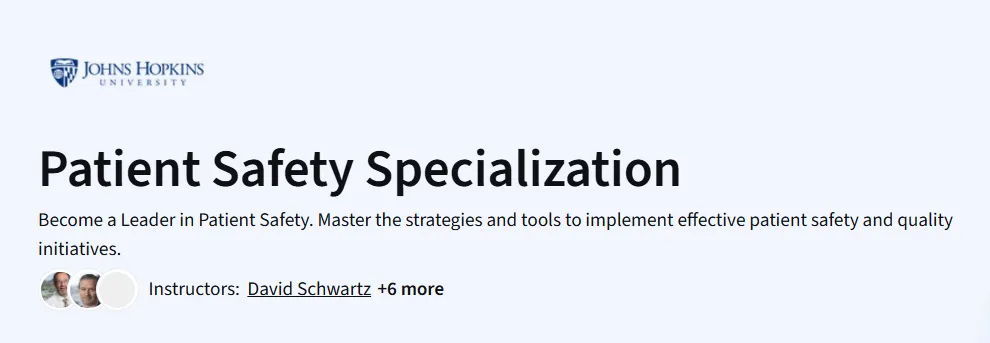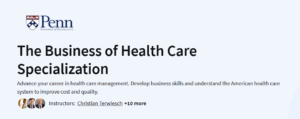What will you learn in Patient Safety Specialization Course
Understand the foundation of patient safety by exploring its history, the concept of high reliability organizations, and the difference between proactive and reactive systems thinking.
Learn how to foster a safety-first environment by building a culture of open communication, accountability, and teamwork that includes patients and families.
Master project planning by applying design thinking, SMART goals, root cause analysis, A3 thinking, and translating research into practice (TRiP).
Develop strategies for long-term success, including pre-mortems to identify project risks, stakeholder engagement, and sustainment planning.
Program Overview
Course 1: Developing a Systems View
⌛ 5 hours
Topics: History of patient safety improvement. High Reliability Organizations. Proactive vs. reactive systems thinking.
Hands-on: Watch videos, read landmark reports, and take a quiz.
Course 2: Safety Culture & Teamwork
⌛ 8 hours
Topics: Core elements of safety culture. Reporting hazards. Role of patients and families. Teamwork strategies.
Hands-on: Engage with videos, readings, and an assignment.
Course 3: Planning Safety & Quality Projects
⌛ 6 hours
Topics: Project scoping. Approach comparisons: A3, Design Thinking, TRiP. Setting SMART goals. Root cause analysis tools.
Hands-on: Apply planning methods and tools in exercises.
Course 4: Designing for Sustainment
⌛ 8 hours
Topics: Planning for lasting change. Premortem risk analysis. Stakeholder engagement (4E’s + 2 model).
Hands-on: Develop change management and stakeholder plans.
Course 5: Implementing Projects
⌛ 10 hours
Topics: Apply the 4E’s and TRiP models. IRB considerations. Address adaptive vs. technical challenges. Scale projects from local to system-level.
Hands-on: Create implementation plans using case studies.
Course 6: Measuring Success
⌛ 7 hours
Topics: Importance of measurement in quality improvement. Data sources and performance measures. Monitoring safety metrics.
Hands-on: Identify and interpret metrics for project evaluation.
Course 7: Capstone Next Level Safety Work
⌛ 12 hours
Topics: Apply your skills to a real-case scenario. Identify defects and root causes. Build A3 plans, change strategies, and measurement tools.
Hands-on: Complete a capstone project with real-world application.
Get certificate
Job Outlook
Ideal for healthcare professionals—like nurses, hospital administrators, or quality managers—who need to lead safety and improvement projects.
Equips healthcare workers to serve as Clinical Leaders or Patient Safety Officers, shaping safer healthcare systems through continuous quality improvement.
Valuable for policy influencers and program designers in healthcare operations, safety assurance, and risk management.
Specification: Patient Safety Specialization
|
FAQs
- No prior experience is required; suitable for beginners.
- Designed for healthcare professionals and those entering the field.
- Focuses on systems thinking, safety culture, and project management.
- Includes practical case studies to apply concepts.
- Accessible to nurses, administrators, and policy professionals.
- Teaches proactive systems thinking and risk prevention.
- Builds safety culture and teamwork strategies.
- Covers project planning using SMART goals, A3 thinking, and TRiP.
- Emphasizes measurement, evaluation, and sustainment of safety initiatives.
- Includes a capstone project to integrate all learned skills.
- Focuses on leadership, process improvement, and culture.
- Not heavily technical; minimal data-heavy analytics.
- Ideal for managers, quality officers, and patient safety leaders.
- Covers strategies for long-term, sustainable improvements.
- Prepares learners for leading healthcare safety initiatives.
- Exercises include project planning and stakeholder engagement.
- Case studies simulate real healthcare system challenges.
- Capstone integrates system view, safety culture, and project implementation.
- Assignments emphasize measurement and evaluation of outcomes.
- Helps learners build practical experience for workplace application.
- Prepares for roles like Clinical Leader or Patient Safety Officer.
- Supports quality management and policy influence in healthcare systems.
- Builds credibility for leadership and improvement projects.
- Skills applicable in hospitals, clinics, and healthcare organizations.
- Enhances employability for safety and quality-focused positions.





